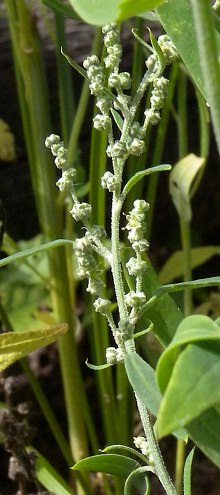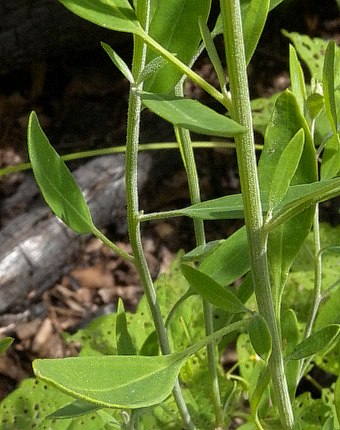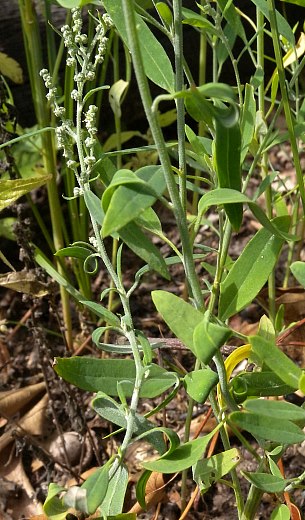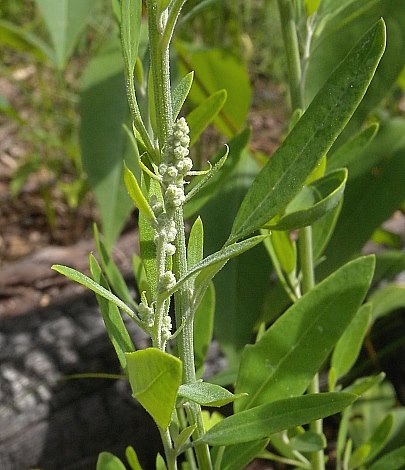 Description:
This plant is a summer annual about ¾-2½' tall that is unbranched or
sparingly branched, except for some axillary inflorescences along the
upper half of its length. The stems are light green with longitudinal
veins that are a more dark shade of green; they are terete and sparsely
to densely white-mealy (farinose). Alternate leaves about ½-1¾" long
and
about one-third as much across occur along the entire length of each
stem; they are narrowly oblong to lanceolate-oblong, usually 3-veined
(except for small upper leaves), and smooth along their margins. Some
of the larger leaves have 1 or 2 shallow basal lobes. The upper
surfaces of the leaves are medium green; they are either sparsely
white-mealy or without the white-mealy characteristic. The lower
surfaces of the leaves are
light green; they are densely to sparsely white-mealy. Usually, young
leaves are more white-mealy than older leaves. The foliage of
Narrow-Leaved Goosefoot is non-aromatic. Both terminal
and axillary panicles of flower occur along the upper half of each
plant; sometimes these inflorescences are reduced to simple spikes. The
terminal panicle is up to 6" long and 2" across, while axillary
panicles are smaller in size. Sessile clusters of flowers
and buds occur along the central stalk and ascending lateral branches
of each panicle; they are all moderately to densely white-mealy.
Individual flowers are less than 1/8" (3 mm.) across, consisting of
5 sepals that are oblong-ovate and keeled, a flattened superior
ovary, and a divided style. There are no petals. The blooming period
occurs from mid-summer into the fall and lasts about 2 months. Only a
few flowers are in bloom at the same time. The flowers can be
cross-pollinated by the wind, otherwise they are self-fertile. Each
flower is replaced by a tiny achene (about 1 mm. across) that is
horizontally flattened and circular in shape; its exterior is black and
shiny. The
achene is surrounded by a membranous covering that is easy to remove.
The root system consists of a taproot. This plant reproduces by
reseeding itself; sometimes small colonies are formed.
Description:
This plant is a summer annual about ¾-2½' tall that is unbranched or
sparingly branched, except for some axillary inflorescences along the
upper half of its length. The stems are light green with longitudinal
veins that are a more dark shade of green; they are terete and sparsely
to densely white-mealy (farinose). Alternate leaves about ½-1¾" long
and
about one-third as much across occur along the entire length of each
stem; they are narrowly oblong to lanceolate-oblong, usually 3-veined
(except for small upper leaves), and smooth along their margins. Some
of the larger leaves have 1 or 2 shallow basal lobes. The upper
surfaces of the leaves are medium green; they are either sparsely
white-mealy or without the white-mealy characteristic. The lower
surfaces of the leaves are
light green; they are densely to sparsely white-mealy. Usually, young
leaves are more white-mealy than older leaves. The foliage of
Narrow-Leaved Goosefoot is non-aromatic. Both terminal
and axillary panicles of flower occur along the upper half of each
plant; sometimes these inflorescences are reduced to simple spikes. The
terminal panicle is up to 6" long and 2" across, while axillary
panicles are smaller in size. Sessile clusters of flowers
and buds occur along the central stalk and ascending lateral branches
of each panicle; they are all moderately to densely white-mealy.
Individual flowers are less than 1/8" (3 mm.) across, consisting of
5 sepals that are oblong-ovate and keeled, a flattened superior
ovary, and a divided style. There are no petals. The blooming period
occurs from mid-summer into the fall and lasts about 2 months. Only a
few flowers are in bloom at the same time. The flowers can be
cross-pollinated by the wind, otherwise they are self-fertile. Each
flower is replaced by a tiny achene (about 1 mm. across) that is
horizontally flattened and circular in shape; its exterior is black and
shiny. The
achene is surrounded by a membranous covering that is easy to remove.
The root system consists of a taproot. This plant reproduces by
reseeding itself; sometimes small colonies are formed.Cultivation: The preference is full or partial sun, dry-mesic to dry conditions, and barren soil that is sandy or gravelly.
Range & Habitat: The native Narrow-Leaved Goosefoot occurs occasionally in southern, west-central, and northern Illinois, while in the rest of the state it is uncommon or absent (see Distribution Map). Some populations of this plant may be adventive. Habitats include upland sandy savannas, stabilized sand dunes, dry sand prairies, gravelly or sandy areas along railroads, and barren waste areas. Habitats with sparse ground vegetation and a history of disturbance are preferred.

Faunal Associations: Various insects feed on Chenopodium spp. These species include the caterpillars of the skippers Pholisora catullus (Common Sootywing) and Staphylus hayhurstii (Hayhurst's Scallopwing); also the caterpillars of several moths, including Amyna octo (Eight-Spot), Blepharomastix ranalis (Hollow-Spotted Snout Moth), Discestra trifolii (The Nutmeg), Grammia virgo (Virgin Tiger Moth), and Scythris limbella (Chenopodium Scythris Moth). Other insect feeders include Norvellina chenopodii (Red-Eyed Leafhopper), the aphids Pemphigus bursarius (Lettuce Root Aphid) and Pemphigus populivenae (Sugar Beet Root Aphid), the plant bug Melanotrichus flavosparsus, and several beetles in the Chrysomelidae: Chaetocnema concinna (Beet Flea Beetle), Disonycha triangularis (Three-Spotted Flea Beetle), Disonycha xanthomelas (Spinach Flea Beetle), Erynephala puncticollis (Beet Leaf Beetle), Monoxia brisleyi (Leaf Beetle sp.), Monoxia elegans (Leaf Beetle sp.), Monoxia obesula (Leaf Beetle sp.), and Systena frontalis (Red-Headed Flea Beetle). Grasshoppers that feed on the foliage of Chenopodium spp. include Campylacantha olivacea (Fuzzy Olive-Green Grasshopper) and Melanoplus lakinus (Lakin's Grasshopper).

Among vertebrate animals, the small abundant seeds of Chenopodium spp. are an important source of food to many granivorous songbirds (see the Bird Table), including the Horned Lark, Mourning Dove, Savannah Sparrow, Vesper Sparrow, and others. The seeds are also eaten by such small rodents as the Prairie Deer Mouse, White-Footed Mouse, and Thirteen-Lined Ground Squirrel. The foliage of non-aromatic Chenopodium spp. is eaten by White-Tailed Deer and various farm animals (sheep & pigs are especially fond of it; see Georgia, 1913). If they are consumed in large quantities, these species are potentially toxic because their foliage contains oxalic acid.
Photographic Location: A stabilized sand dune near Lake Michigan at Indiana Dunes State Park in NW Indiana.

Comments: Narrow-Leaved Goosefoot is similar to a form of Lamb's Quarters with narrowly lanceolate leaves, Chenopodium album lanceolatum (sometimes this form is classified as a variety of Lamb's Quarters, or even a distinct species, Chenopodium lanceolatum). Narrow-Leaved Goosefoot differs from this form of Lamb's Quarters by having leaves with 3 veins and 0-2 basal lobes; the lanceolate form of Lamb's Quarters has single-veined leaves that lack lobes of any kind. While Narrow-Leaved Goosefoot has membranous coverings on its achenes that can be easily rubbed off, all forms, variants, and subspecies of Lamb's Quarters have achenes with tight membranous coverings that are removed with difficulty. Another species in this genus that is even more similar, Entire-Leaved Goosefoot (Chenopodium dessicatum), differs from Narrow-Leaved Goosefoot by having leaves with no basal lobes. It tends to be a more petite plant with smaller leaves and shorter petioles; it also differs by having leaves that are more white-mealy (especially on their lower sides). Both of these species have achenes with loose membranous coverings and their larger leaves are 3-veined. Some authorities (currently a minority) classify Narrow-Leaved Goosefoot as a variety of Entire-Leaved Goosefoot, or Chenopodium dessicatum leptophylloides.